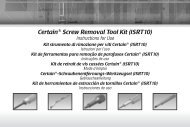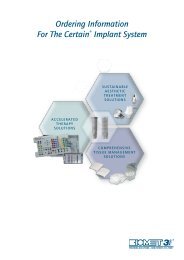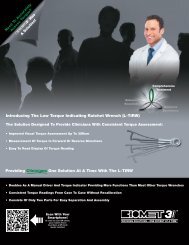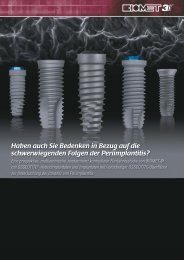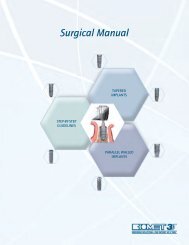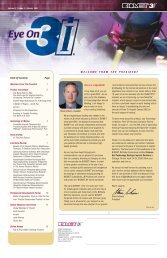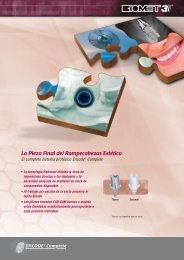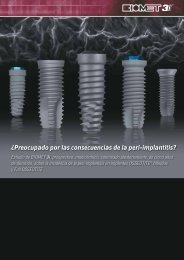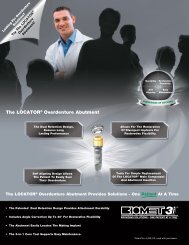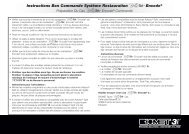Create successful ePaper yourself
Turn your PDF publications into a flip-book with our unique Google optimized e-Paper software.
Important Product Information For<br />
Dental Implants<br />
Instructions For Use:<br />
For a detailed explanation of the osteotomy preparation and<br />
implant placement guidelines, please refer to the appropriate<br />
<strong>Surgical</strong> Manual(s).<br />
Description:<br />
<strong>BIOMET</strong> <strong>3i</strong> Dental Implants are manufactured from biocompatible<br />
titanium or titanium alloy. <strong>BIOMET</strong> <strong>3i</strong> Dental Implants include<br />
various surface treatments. For specific product descriptions,<br />
please refer to individual product labels.<br />
Indications For Use:<br />
<strong>BIOMET</strong> <strong>3i</strong> Dental Implants are intended for surgical placement<br />
in the upper or lower jaw to provide a means for prosthetic<br />
attachment in single tooth restorations and in partially or fully<br />
edentulous spans with multiple single teeth utilizing delayed<br />
loading, or as a terminal or intermediary abutment for fixed or<br />
removable bridgework, and to retain overdentures. <strong>BIOMET</strong> <strong>3i</strong><br />
T3 ® , NanoTite and OSSEOTITE ® Dental Implants may also<br />
utilize immediate loading for these indications.<br />
<strong>BIOMET</strong> <strong>3i</strong> T3, NanoTite and OSSEOTITE Dental Implants are<br />
intended for immediate function on single tooth and/or multiple<br />
tooth applications when good primary stability is achieved, with<br />
appropriate occlusal loading, in order to restore chewing function.<br />
Contraindications:<br />
Placement of dental implants may be precluded by both patient<br />
conditions that are contraindications for surgery as well as<br />
hypersensitivity to commercially pure titanium or titanium alloy<br />
(including vanadium, aluminum and calcium phosphate).<br />
<strong>BIOMET</strong> <strong>3i</strong> Dental Implants should not be placed in patients<br />
where the remaining jaw bone is too diminished to provide<br />
adequate implant stability.<br />
Warnings:<br />
Excessive bone loss or breakage of a dental implant may occur<br />
when an implant is loaded beyond its functional capability.<br />
Physiological and anatomical conditions may affect the<br />
performance of dental implants.<br />
Mishandling of small components inside the patient’s mouth<br />
carries a risk of aspiration and/or swallowing.<br />
Forcing the implant into the osteotomy deeper than the depth<br />
established by the drills can result in damage to the implant,<br />
driver or osteotomy.<br />
For short implants, clinicians should closely monitor patients for<br />
any of the following conditions: peri-implant bone loss, changes<br />
to the implant’s response to percussion or radiographic changes<br />
in bone to implant contact along the implant’s length. If the<br />
implant shows mobility or greater than 50% bone loss, the<br />
implant should be evaluated for possible removal. If a clinician<br />
chooses a short implant, then the clinician should consider a<br />
two-stage surgical approach, splinting a short implant to an<br />
additional implant and placement of the widest possible fixture.<br />
In addition, the clinician should allow longer periods for<br />
osseointegration and avoid immediate loading.<br />
Reuse of <strong>BIOMET</strong> <strong>3i</strong> Products that are labeled for single-use<br />
may result in product contamination, patient infection and/or<br />
failure of the device to perform as intended.<br />
MRI Statement:<br />
<strong>BIOMET</strong> <strong>3i</strong> Dental Implants have not been evaluated for safety,<br />
heating, migration, or compatibility in the Magnetic Resonance<br />
Imaging (MRI) environment.<br />
Precautions:<br />
These devices are only to be used by trained professionals.<br />
The surgical and restorative techniques required to properly<br />
utilize these devices are highly specialized and complex<br />
procedures. Improper technique can lead to implant failure,<br />
loss of supporting bone, restoration fracture, screw loosening<br />
and aspiration. When the clinician has determined adequate<br />
primary stability is achieved, immediate functional loading can<br />
be considered.<br />
The following should be taken into consideration when placing<br />
dental implants: bone quality, oral hygiene and medical<br />
conditions such as blood disorders or uncontrolled hormonal<br />
conditions. The healing period varies depending on the quality<br />
of the bone at the implantation site, the tissue response to the<br />
implanted device and the surgeon’s evaluation of the patient’s<br />
bone density at the time of the surgical procedure. Proper<br />
occlusion should be evaluated on the implant restoration to<br />
avoid excessive force during the healing period on the implant.<br />
It is recommended that implants less than 4mm diameter NOT<br />
be placed in the posterior regions.<br />
Sterility:<br />
All dental implants are supplied sterile and are labeled “STERILE”.<br />
All products sold sterile are for single-use before the expiration<br />
date printed on the product label. Do not use sterile products<br />
if the packaging has been damaged or previously opened.<br />
Do not re-sterilize.<br />
Storage And Handling:<br />
Devices should be stored at room temperature. Refer to<br />
individual product labels and the <strong>Surgical</strong> Manual for special<br />
storage or handling conditions.<br />
Potential Adverse Events:<br />
Potential adverse events associated with the use of dental<br />
implants may include: failure to integrate, loss of integration,<br />
dehiscence requiring bone grafting, perforation of the maxillary<br />
sinus, inferior border, lingual plate, labial plate, inferior alveolar<br />
canal or gingiva, infection as reported by abscess, fistula,<br />
suppuration, inflammation, or radiolucency, persistent pain,<br />
numbness, paresthesia, hyperplasia, excessive bone loss<br />
requiring intervention, implant breakage or fracture, systemic<br />
infection, nerve injury and aspiration.<br />
Caution:<br />
U.S. Federal Law restricts this device to sale by or on the order<br />
of a licensed dentist or physician.<br />
49



